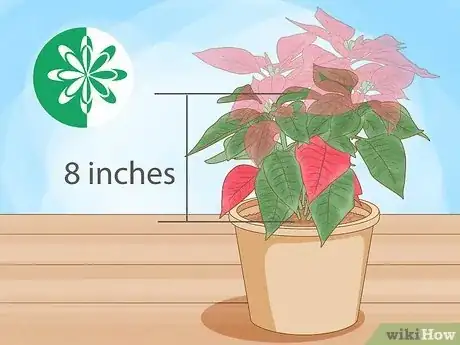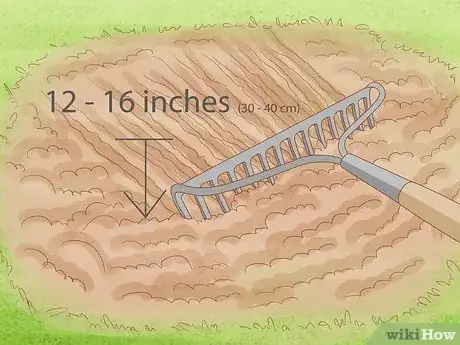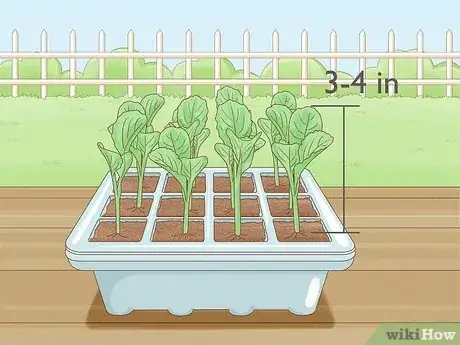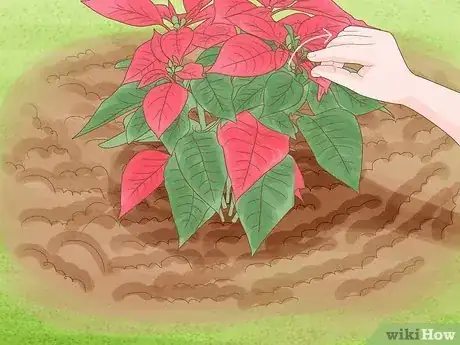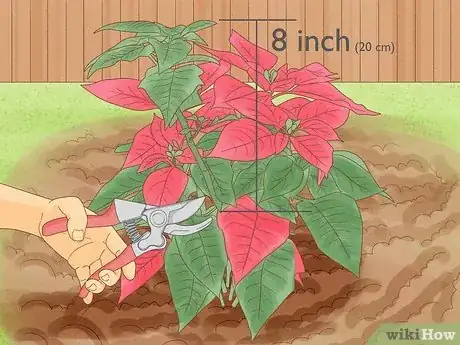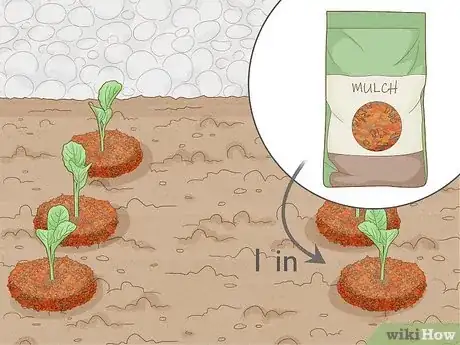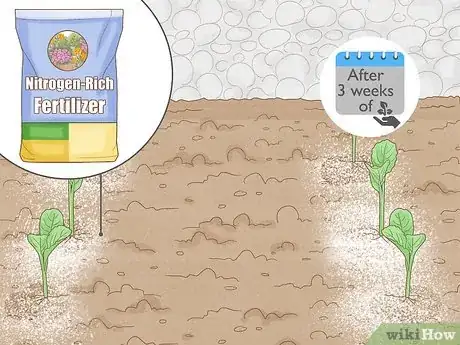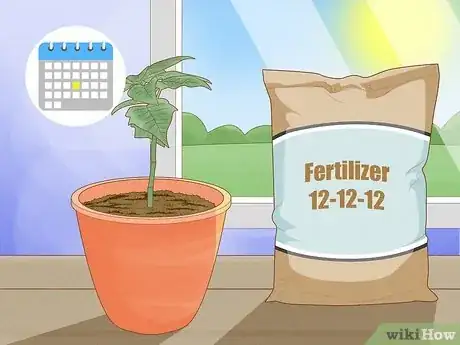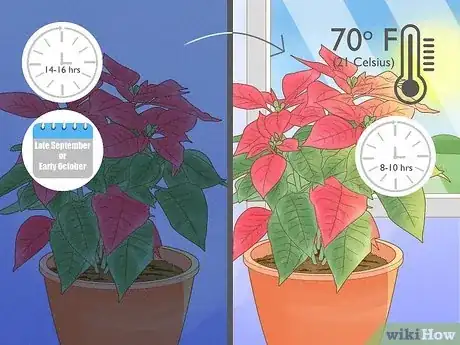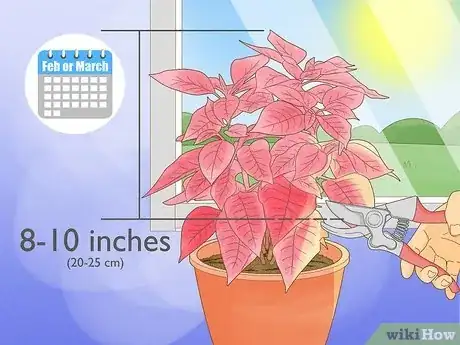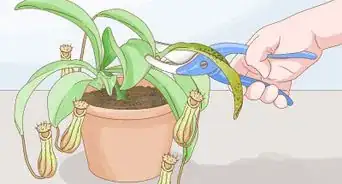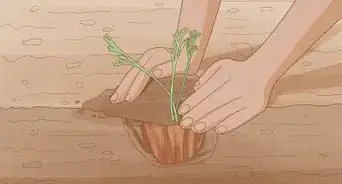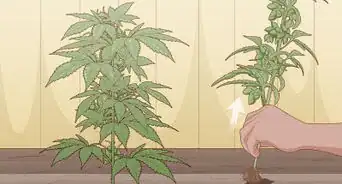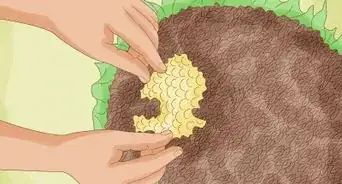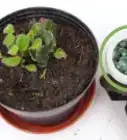This article was co-authored by Katie Gohmann. Katherine Gohmann is a Professional Gardener in Texas. She has been a home gardener and professional gardener since 2008.
wikiHow marks an article as reader-approved once it receives enough positive feedback. This article received 17 testimonials and 95% of readers who voted found it helpful, earning it our reader-approved status.
This article has been viewed 235,023 times.
Poinsettia plants are native to Mexico, where they can grow up to 16 feet (4.9 m) tall. Many people buy poinsettia plants to decorate for Christmas and aren't sure how to care for them when the red leaves fall away. If you live in a place with mild winters, you can plant the poinsettia outside as a perennial. Those in chillier climates may grow poinsettias as houseplants year round. See Step 1 and beyond to learn more about both approaches.
Steps
Growing Poinsettia as a Perennial
-
1Decide whether the climate is right. If you live in a place with mild winters - growing zone 10-12 or higher - you should be able to plant the poinsettia directly in the ground, where it will grow as a perennial and get larger with each passing year. If you're in a place where the temperature dips to freezing temperatures during the winter, you're better off keeping it in the pot as a houseplant. Poinsettia are native to Mexico, and they need a warm climate to thrive.[1]
-
2Care for the poinsettia until spring. If you bought the poinsettia during the winter as a decoration, keep the plant in the pot until spring, even if you live in a place with mild winters. If it came in foil remove the wrapper so water can drain from the pot. It needs to stay potted until the weather gets warm enough to transplant it. Water it whenever the soil starts to dry out.
- At the beginning of spring, in March or April, cut the poinsettia back to about 8 inches. This will encourage it to begin a new growing cycle and get it ready for transplanting.
- Keep it watered and fertilize it once a month or so until early summer, when it's time for transplanting.
Advertisement -
3Prepare a planting spot. Look for a place where the poinsettia will get morning sun as well as light or partial shade during the heat of the afternoon. Till the soil and loosen it to a depth of 12 to 16 inches (30 to 40 cm). Enrich the soil by adding organic compost if necessary. Poinsettias prefer rich, well-drained soil.
-
4Plant the poinsettia. Dig a hole as wide as the poinsettia's root ball and plant the poinsettia. Pat soil gently around the base of the stem. Mulch the area around the base of the plant with 2 to 3 inches (5 to 7 cm) of organic mulch. This keeps the soil cool and helps it retain moisture.
-
5Fertilize the poinsettia. You can apply a 12-12-12 or 20-20-20 compound at the start of the growing season or fertilize the plant with compost. If your soil is not very rich, you may need to fertilize the plants once a month.
-
6Water the poinsettia throughout the growing season. Water the plant at the base whenever the soil around the plant feels dry to the touch. Avoid overhead watering, which could cause fungal disease to form on the leaves of the plant.[2]
-
7Prune the poinsettia. Pinch small growing shoots from poinsettias occasionally throughout the growing season to encourage the plants to flower. You can discard the shoots or use them to propagate new plants. Cut back old growth in late fall or early winter to encourage strong new growth the following spring.[3]
-
8Propagate poinsettia cuttings. You can take 8 inch (20 cm) cuttings from the soft growing tips of poinsettia stems or 18 inch (45 cm) cuttings from the woody stems of the plant to create new poinsettia.
- Dip the ends of each cutting into a rooting hormone, then insert it into a pot filled with potting soil or a vermiculite mix.
- Keep the soil in the pot moist, but not wet, for several weeks while the cuttings make roots.
-
9Overwinter the poinsettia. Add fresh mulch around the base of the plant to keep the soil warm for the winter months. Poinsettia can winter over in areas where soil temperatures do not fall below 45 degrees Fahrenheit (7 Celsius). Dig the plants up and bring them indoors if you live in a climate where winters are cold and soil temperatures fall below 45 degrees Fahrenheit (7 Celsius).
Growing Poinsettia as a Houseplant
-
1Care for the poinsettia until spring. If you bought the poinsettia during the winter, keep it watered throughout the winter and into spring.
-
2Repot the poinsettia in early summer. Choose a pot that's only slightly larger than the original pot, and repot the poinsettia with a rich potting mix that is high in organic matter.[4] This will give the poinsettia a good head start for the growing season.
-
3Give the plant plenty of sun. Place your potted poinsettia plant near windows that receive bright, but indirect, morning sun. Choose windows that are not drafty to avoid exposing the plants to cold air. Poinsettias need to be kept at a temperature of around 65 degrees and do not handle extreme temperature changes well.
- If the summer temperature is warm enough and never drops below 65 degrees at night, you may keep the poinsettia outside during the growing season. Place the plant in an area that gets partial shade.[5]
-
4Water the poinsettia well. Water indoor poinsettias throughout the spring and the growing season whenever the top inch of soil feels dry to the touch. Add water to the pots slowly, and wait for the soil to absorb the water before adding more. Stop watering when saturation slows, and before excess water pools on the soil's surface.
-
5Fertilize monthly. Potted poinsettia need to be fertilized often with a well rounded liquid fertilizer. A 12-12-12 or 20-20-20 compound is best. Repeat fertilization every month. Stop fertilizing in the fall when it is time for the plants to flower.
-
6Prune the poinsettia. Pinch small growing shoots from poinsettias occasionally throughout the growing season to keep the poinsettia compact and bushy.[6] You can discard the shoots or use them to propagate new plants. Cut back old growth in late fall or early winter to encourage strong new growth the following spring.
-
7Overwinter the poinsettia. In the fall, it's time to bring the poinsettia back inside so it doesn't freeze. You must also create a cycle of long uninterrupted nights and short sunny days during the fall and winter to encourage the leaves to change from green to red. Do this for 9 to 10 weeks until flower bracts begin to form on the plant.
- Move the poinsettias to an area where they receive total darkness for 14 to 16 hours a day in late September or early October. A cool closet is the best location, but if one is not available, you can also put the plants into a large box for their uninterrupted dark hours. Any light exposure during this time will delay the color change.
- Keep the plants in total darkness at the time when temperatures are coolest. The best hours are from 5:00 p.m. to 8:00 a.m. Poinsettias flower best when nighttime temperatures are 55 to 60 degrees Fahrenheit (12 to 16 Celsius).
- Bring the plants out of darkness every morning and put them near a sunny window where temperatures stay around 70 degrees Fahrenheit (21 Celsius).
-
8Display poinsettias when the leaves turn red. By December, the poinsettia should be ready to display as a holiday decoration again. Place the plant in a sunny window and leave it exposed to normal household light through the winter flowering season.
-
9Encourage dormancy once the flower bracts begin fading. When the small yellow flowers at the center of the leaves wilt, in February or March, it's time for the plant's dormancy period.
- Prune the plants heavily to 8 to 10 inches (20 to 25 cm) tall. This is a good time to take cuttings for plant propagation.
- Cut back on watering for a couple of months until it is time to start new growth in the spring. Allow the top several inches of soil to dry out before watering them.
Expert Q&A
Did you know you can get expert answers for this article?
Unlock expert answers by supporting wikiHow
-
QuestionAfter I prune the plants heavily in February or March where should I keep it?
 Katie GohmannKatherine Gohmann is a Professional Gardener in Texas. She has been a home gardener and professional gardener since 2008.
Katie GohmannKatherine Gohmann is a Professional Gardener in Texas. She has been a home gardener and professional gardener since 2008.
Professional Gardener
-
QuestionIf my poinsetta is covered for four days with no light will it influence the blooming process?
 Katie GohmannKatherine Gohmann is a Professional Gardener in Texas. She has been a home gardener and professional gardener since 2008.
Katie GohmannKatherine Gohmann is a Professional Gardener in Texas. She has been a home gardener and professional gardener since 2008.
Professional Gardener
-
QuestionHow do I make sure my poinsettia isn't dying?
 Community AnswerKeep checking the leaves to ensure they're not drooping, as this can be a good sign of either over- or under-watering the plant.
Community AnswerKeep checking the leaves to ensure they're not drooping, as this can be a good sign of either over- or under-watering the plant.
References
- ↑ http://www.mnn.com/your-home/organic-farming-gardening/stories/how-to-grow-and-re-bloom-poinsettias
- ↑ http://www.mnn.com/your-home/organic-farming-gardening/stories/how-to-grow-and-re-bloom-poinsettias
- ↑ http://www.aces.uiuc.edu/vista/html_pubs/point/point.htm
- ↑ http://www.mnn.com/your-home/organic-farming-gardening/stories/how-to-grow-and-re-bloom-poinsettias
- ↑ http://www.sheknows.com/home-and-gardening/articles/977967/poinsettias-how-to-keep-them-thriving-year-round
- ↑ http://www.mnn.com/your-home/organic-farming-gardening/stories/how-to-grow-and-re-bloom-poinsettias
- http://www.gardeningchannel.com/poinsettia-gardening-tips/
- http://www.thegardenhelper.com/poinsettiaoutdoors.html
About This Article
To grow a poinsettia that you bought during the winter, keep it in the pot until spring, since you only want to transplant it during the warmer months. When you’re ready to plant outside, cut the poinsettia back to about 8 inches to encourage a new growth cycle Then, dig a 12-16 inch hole in an area with light or partial shade, and plant the poinsettia in the hole. Once planted, use 2-3 inches of organic mulch on top of the soil to help the soil drain. Throughout the growing season, water the plant at the base whenever the soil feels dry to the touch. For more tips from our Horticultural reviewer, including how to repot your poinsettia if you’re growing it as a houseplant, keep reading!

